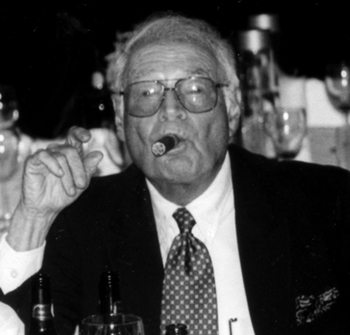
Lew Sayre Schwartz has passed away at the age of 84. Lew's son Andrew informed me by email yesterday that Lew died as the result of a head injury from a fall last month.
Lew was born in 1926. In the years following the second world war a 21-year-old Lew picked up work ghosting Batman comic book stories for Bob Kane. He penciled some 120+ individual Batman shorts between 1947 and 1953. He would typically pencil the entire job from the DC script, over which Kane might add his own touches to the main figures of Batman and Robin before sending it in. Lew ghosted some other stuff here and there, on newspaper daily strips including weeks on Secret Agent X-9 for Mel Graff, and weeks on The Saint. His signature never appeared on any of this work, but Lew was well known among practitioners of the comic strip. He made a great documentary about Milton Caniff in 1981, in which several luminaries of our art are interviewed on video, including the great Noel Sickles.

Lew left comics in the mid 1950s following a junket in Korea entertaining the troops, for which he traveled with a bunch of other cartoonists, including Irwin Hasen. "When I got back, I couldn't stand drawing another page" of Batman, he told me, and from there he went into television advertising, at first drawing storyboards.
in 1961 Lew co-founded the irreverent TV commercial production company Ferro, Mogubgub and Schwartz. They worked on the Kubrick movie Dr. Strangelove, for which they brought an innovative style to the lettered credits. His long career in television would come to include segments for Sesame Street and the direction of a Barbara Streisand special.
In retirement ("There is no retirement," he told me) Lew came back to the comics medium, collaborating with Dick Giordano on a short adaptation of Moby Dick for the kids' market as well as as strip titled The Dinosaur Group that appeared for five years on the editorial page of The Standard Times, an East Coast paper. It was at this time, in 2002, that he was rediscovered by the world of comics. He was a guest at the San Diego Comic-Con that year and again in 2009.

I knew and recognized Lew's Batman work when it was still anonymous, and I wrote about it once in an online essay (click here for further reading). I loved his throngs of little figures that seemed to live on a different scale from the figures of other artists working the field. They had a jaunty humour in contrast to the grotesqueness of Dick Sprang, who was working contemporaneously with Schwartz, and who was credited earlier because he worked through the DC office. My article led to an introduction to the artist, whom I interviewed by phone for a short-lived magazine I produced. That in turn led to me interviewing him onstage in San Diego in 2002. From the start we kind of adopted each other and kept in touch by phone. My concept of myself as an artist, apt to get overblown, was kept in check by his good humour and wise overview of the business of making a living from being creative. Lew was a natural storyteller with a funny anecdote for every occasion, neatly crafted and delivered in a measured tempo. My favourite is the one about Bill Mauldin, who, after being told by his wife that she was leaving him, got drunk and went to the publisher's office to try to tear her out of the dedication page of every copy of his just-printed book.
Lew was my rainbow-bridge connection to the great age of American cartoonists, a world full of larger than life characters, who all seem much further away now that Lew has gone.
[Update, June 22: Below is a three-page sequence from The Joker's Journal, Detective Comics #193, 1953, which shows off Schwartz's skills as a cartoonist.]









